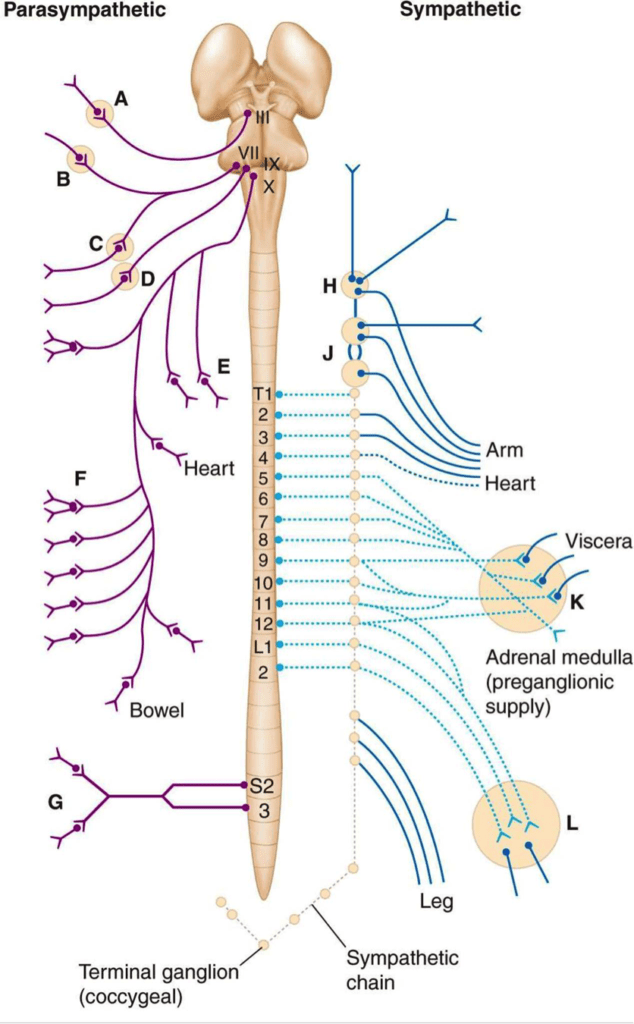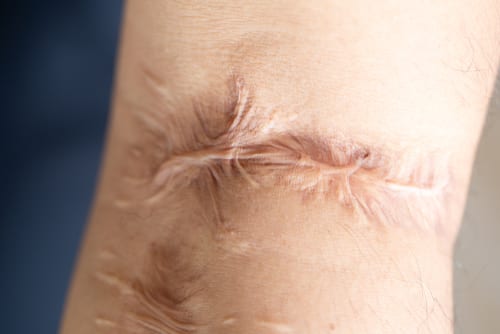In this article we will dive into how the skin and fascia, our protective barrier to the outside world, is key to the function of our nervous system, how scars can severely disrupt critical communication within this system, and how Scar Release Therapy using microcurrent point stimulation (MPS) can help release these hidden barriers and restore the flow of information throughout the body.
As a country and a culture we tend to deal with the crisis in front of us. We move quickly through our days, weeks, months, putting out fires and handling the next thing that demands our attention. We frequently treat our bodies the same way. We tend to lean into the quick fix for that headache, painful neck, stiff knee, and upset stomach without really searching for the underlying cause of our discomfort. As a Physical Therapist here at the Center for Healing and Regenerative Medicine (CHARM) my goal is to identify the root cause of your body’s dysfunction and help remove the barriers to recovery.
Over the last decade, I have become more and more fascinated by the role scars play in how our bodies function. In 1999 I, like one-third (31.7% in 2019 as reported by https://www.cesareanrates.org/) of women in the United States, had a pregnancy and delivery end in major abdominal surgery. Not a term anyone likes to throw around to an expectant mama, but it is the correct description for a cesarean section. Mine, like most, was necessary even critical to help ensure the safe birth of a healthy baby boy. I would not have had it any other way.
My recovery was good. I felt strong and capable and was blessed with two more sons born via VBAC – Vaginal Birth After Cesarean. No worries about that scar, right, that puppy was healed! But even now, 20 years later, when my body gets run down, ill, significantly stressed, or overly fatigued, I feel this lower abdominal scar. I can barely see it any longer, but I can feel it – – tender, aching, present.

Scars and the Nervous System
Scar tissue is inherently different from normal skin, dermal, and fascial tissues due to the rapid response healing team brought into play when a wound needs to be closed. This is a critical protective mechanism of our body in order to assist in survival after a wound or injury of any kind including surgery. To understand why scars can be so disruptive we must first understand a bit about the integumentary system they impact.
The epidermis or surface layer of the skin originates from the embryonic sheet referred to as the ectoderm. Interestingly, the central and peripheral nervous system as well as some components of the endocrine and immune system are also derived from this ectodermal layer. This explains the complex and comprehensive integration of the skin with the entire nervous system and how scar tissue can affect regions of the body and systems in areas remote from the scar location. This enormous organ exchanges information between our external and internal world and is constantly electrically active.
The next layer, the dermis, is derived from the mesoderm and shares its origin with connective tissue, cartilage, bone, blood, and associated organs. Below the dermis and also originating from the mesoderm is the subcutaneous fat layer and then fascia. Fascia can be considered the “philosophy of the body” because it surrounds every muscle, bone, nerve, and organ literally connecting every body region to the other. Deeper wounds and certainly surgery disrupt all of these layers of tissue.

Scar Formation
Healing a wound is a complex sequence of events occurring in four main stages including hemostasis, inflammation, proliferation, and remodeling. I will not go into detail around the healing process today, but it is worth the research because it is dependent on so many physiologic processes working seamlessly together. Truly a subconscious miracle performed by our bodies on a moment to moment basis, and the foundation of the practice of Regenerative Medicine.
A few aspects of the proliferation and remodeling stages are critically important to note when discussing scars. During the proliferation stage, myofibroblasts increase the traction force across the lesion contracting and reducing the open surface area in preparation for remodeling. During remodeling, which can last for more than a year, collagen is lined up in no specific order and is smaller in fiber diameter than the collagen of intact skin. The resultant scar, both external and internal, is now strong but less elastic than before injury.
Studies show scar tissue also changes in polarity of electrical charge. Normal tissue is naturally negative in polarity, but a scar will exhibit more positive charge. This helps explain how adhesions and subsequent nerve entrapment can be a complication of scar formation. It is like having a kink in the hose of the delicate flow of neural information, or a snag in the continuous myofascial sweater.
Scar Complications
We now have an understanding of skin and fascia and how these tissues are interconnected with the nervous and musculoskeletal systems. We also briefly discussed how a wound is closed and a scar is formed. Let’s now explore the possible effect of the resultant scar including adhesions, impaired blood flow, nerve entrapment, muscle tension, polarity change, and disruption of the autonomic nervous system.
Many authors have used the analogy of roadways to define energy meridian and neural pathways, and roadblocks to describe scars. We can visualize how information traveling both from below the scar to the brain (afferent information), and from the brain to the body below the scar (efferent information) would be disrupted especially with scars on the back / torso and those that run horizontally.
This may cause an area of excessive energy build up around the scar as the traffic along a roadway is blocked, or a detour of the information traffic onto roads not normally driven, causing neurological chaos. Evidence shows the deeper the wound and scarring through fascia and viscera the greater the evidence of disruption with incidence of internal adhesions following abdominal surgery reaching close to 100%.

Sympathetic Nervous System Load
An additional component to consider is the amount of sympathetic load through an individual’s entire nervous system and how this affects the “activity” of the scar. The autonomic nervous system is comprised of two subsystems, the sympathetic and parasympathetic.
The sympathetic branch of our nervous system becomes up-regulated when we require the strength to fight or flee. Its purpose is protection and survival. Its action is to shunt all energy to the musculoskeletal system so we are capable of taking on or running away from a predator.
In contrast, the parasympathetic state is one of calm with the goal of rest, restoration, digestion, and healing. Since 80% of the sympathetic nervous system fiber network goes through the layers of the skin (the blue arrows seen in the illustration), we can appreciate when our body is stressed (ill, exhausted, injured, fearful, depressed, poorly nourished, etc.) our scars may become more active, tender, positively polarized, and disruptive. This is why I again feel my C-section scar when my body is run down. Studies show 1/3 of individuals present with some extent of Chronic Post Surgical Pain (CPSP) at one-year post procedure, with 80% of the symptoms being distal or distant from the surgical site.
Scar Release Therapy Using Microcurrent Point Stimulation
Direct current is the current our body recognizes as its own. Microcurrent Point Stimulation (MPS) uses a direct current protocol to release scar tissue adhesions, repolarize mechanoreceptors, relax surrounding muscle tissue, and stimulate specific acupuncture points to assist the nervous system to shift from sympathetic dominance to one of parasympathetic down-regulation. Scar Release Therapy using Microcurrent Point Stimulation (MPS) can change the output of the nervous system by changing the sensory input using direct afferent current.
In a study of 47 patients with chronic post surgical pain (CPSP) following C-section, the application of low frequency, concentrated, direct microcurrent stimulation showed positive results. Using a Visual Analogue Scale (VAS) the participant’s pain level was recorded before treatment. The VAS response immediately following treatment reflected a 67.5% reduction in pain level, and an impressive 82.2% reduction at 48 hour follow up. We have seen similar results here in the clinic. In addition to direct scar pain / hypersensitivity relief, we have also seen improved sleep patterns, digestive function, range of motion, and overall mobility and wellbeing.
A combination of studies on the treatment of C-section scars referenced at https://www.mpscourses.com/scar-release-therapy/ shows 24% reduction in scar size after just one application, 75% reduction of post surgical scar pain, and 82% reduction in neck, back, and shoulder pain again following repeated release of a distant lower abdominal scar. More studies on scar release therapy using Microcurrent Point Stimulation can be found at https://charmaustin.com/restore-function-and-return-to-living/microcurrent-point-stimulation/.

Below is a testimonial from one of our new moms in our Postpartum Restoration https://charmaustin.com/restore-function-and-return-to-living/postpartum-wellness/ program here at CHARM. She experienced Scar Release Therapy using Microcurrent Point Stimulation.
“Using MPS on my C-section scar has been game changing. Immediately after an MPS session, I could feel and see that my scar had released. Instantaneously I could stand up and not feel pulling on my scar. Scar massage is painful and scary — MPS is painless and I saw immediate results.” Sarah.
The Body does the Healing
Here at CHARM we believe in a fundamental truth – The Body Does The Healing. To assist the body in that healing the Physical Therapy Department at CHARM uses the philosophy of Release / Balance / Build. The use of microcurrent point stimulation is one of our foundational approaches to scar and tissue release. Understanding how the release of scar and other tissue adhesions is intimately interrelated to the function of the autonomic nervous system, chronic sympathetic up-regulation, perception of pain, fear of motion, and altered neuromuscular control assists in bringing together synergistic therapies.
Both the closed kinetic chain, body-weight off-loading Neurac Method https://charmaustin.com/restore-function-and-return-to-living/neuromuscular-activation-method/ and the direct current NeuFit Method https://charmaustin.com/restore-function-and-return-to-living/neufit/ use high nervous system and proprioceptive input to change and balance the output of proper neuromuscular control. Once the system is released for full communication and balanced for proper neuromuscular control, then we can utilize any and all tools, strategies, challenges, and progressions to optimize individual potential and performance.
See more of our Release / Balance / Build https://charmaustin.com/release-balance-build/ therapy approach that can take you from fear and protection to potential and optimal performance here at CHARM.
Michele Zink Harris, PT, CNP, RAS
Primary Source:
Journal of Multidiscip Health. 2014; 7:11-24.
Skin, Fascias, and Scars: Symptoms and Systemic Connections.





